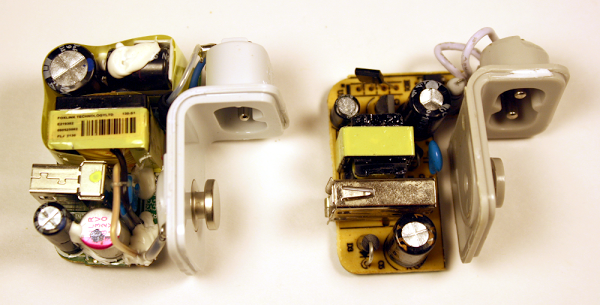One of the side effects of the tremendous popularity of iPhones and iPads has been the counterfeit Apple product market, which looks to lure in consumers who want to purchase items like chargers for less money than Apple’s official offerings.
However, those counterfeit chargers can be fairly dangerous, as highlighted by the tragic story of a Chinese woman who was electrocuted by a counterfeit charger while charging her iPhone last year. Following up his look at the difference between real and counterfeit iPhone chargers, Ken Shirriff has taken to his blog (via Daring Fireball) to explore the differences between the real and fake iPad chargers.
 Apple’s official iPad charger (left) vs counterfeit (right).
Apple’s official iPad charger (left) vs counterfeit (right).
He compared the differences between Apple’s real $19 iPad charger and a $3 he found on eBay. While they look exactly the same on the outside, he found major differences on the inside. Apple’s charger is crammed full of bigger, higher quality components while the counterfeit has low-quality components and more space. Another difference was a safety measure:
One safety difference is obvious: the Apple charger has much more insulation. The upper (high-voltage) half is wrapped in yellow insulating tape. Some components are encased in shrink tubing, there are plastic insulators between some components, and some wires have extra insulation. The counterfeit charger only has minimal insulation.
Flipping the boards over reveals another obvious safety difference: Apple’s charger includes red insulating tape while the counterfeit does not. One not-so-obvious difference is the space between high and low voltage currents running through the boards. While Apple’s charger includes a safe 4mm separation between the two, the counterfeit only features a 0.6mm separation. Shirriff notes this means a simple drop of condensation could cause the charger to zap the user.
Another key difference is the power output. Apple’s charger outputs 10W at a steady rate while the counterfeit outputs 5.9W with frequent spikes, which means that Apple’s charger charges the iPad quicker with a higher quality of energy.
Shirriff goes into far greater detail with extensive images and graphs detailing the specific differences between Apple’s real iPad charger and the counterfeit. The full comparison is available on his blog. Users who believe they have a counterfeit charger may take part in Apple’s third-party charger takeback program.![]()

